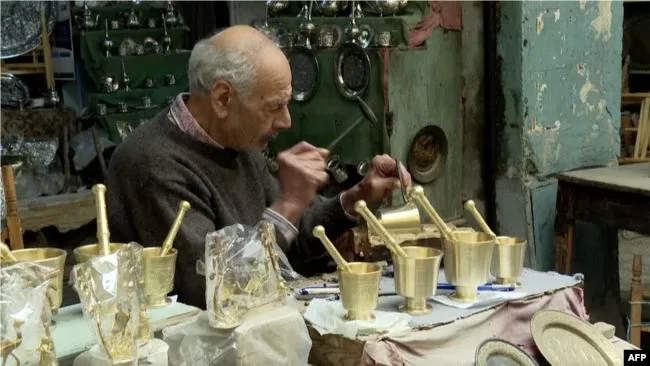Tunis – UNESCO has recently recognized the ancient tradition of metal engraving as an important part of North African craftsmanship. This recognition has brought attention to the mastery of Mohamed Amine Htiouich, a Tunisian artisan who started as an apprentice in his teenage years and has now become a master of the craft.

Mohamed Amine Htiouich started refining his metal engraving skills as a teenager and has carried on this passion into his 37th year. He hails from Tunisia and has mastered the art of working with copper, silver, and gold at his family’s workshop in the old medina of Tunis. The next generation benefits from his dedication to passing on this ancient craft.

For Htiouich, the fear of this tradition fading away further fuels his commitment to providing free apprenticeships to young enthusiasts eager to learn the meticulous process of manually cutting words or symbols into jewellery and household items—a practice traditionally passed down from fathers to sons. “I don’t want to see this tradition disappear,” he emphasized, expressing concerns about the lack of succession.
While UNESCO’s acknowledgement is a step forward for this age-old tradition, local artisans bemoan the undervaluation and inadequate government support for metal engraving within their communities. Imed Soula, a Tunisian artisan instrumental in getting engraving nominated for the UNESCO list, sees the designation as a commitment to preserving the exceptional know-how associated with this craft.

In Tunisia, Chiheb Eddine Ben Jabballah, a seasoned artisan and head of Tunisia’s national chamber of craftsmen, dedicates his workshop to teaching the craft to women aspiring to create jewellery or baskets adorned with chiselled-copper ornaments. However, the brevity of apprenticeships, often lasting only three months, is a concern for him, as mastering engraving techniques require a minimum of two years.
Despite the international recognition, artisans like Abdelilah Mounir in Morocco anticipate positive impacts on tourism and commerce. However, Mohamed Moumni, a jeweller from Sale, Morocco, highlights a different challenge—finding skilled craftsmen due to the scarcity of those familiar with the intricate art of metal engraving.

In Libya, amidst political turmoil, Youssef Chouchine, one of the few remaining craftsmen in Tripoli’s medina, laments the lack of support for this ancient craft. Algeria faces similar challenges where public initiatives are scarce. However, the demand for engraved metal remains high.
Walid Sellami, a 37-year-old jewellery designer from Algiers, considers metal engraving a “magnificent trade.” Despite the limited availability of training in his city, Sellami learned the craft from the internet. While he believes the UNESCO designation won’t bring significant change, he is “happy and proud” that this ancestral custom has gained more recognition on the global stage.


